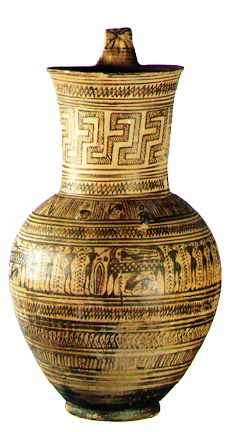The geometric style of Greek vase painting began around 1000 BCE. The symmetrical, wheel-thrown vessels are the prototypes for the standard range of Greek vase shapes throughout later Greek culture. Fully developed by 700 BCE, geometric Greek pottery is characterized by designs painted in black slip over the lighter body, with circular bands of pattern, most often geometric in nature covering the entire exterior surface of the vessel. On this particular pitcher, the bands of geometric pattern serve to accent the central banded area in which the narrative is told. This piece records a funeral scene, and was intended as a burial object. In the central panel we can see the funeral procession taking place, with rows of grieving women flanking the deceased on a raised funeral table (bier). The funeral bier takes the form of a four legged animal, with the deceased laid out on the back of the animal, with a shroud covering the body. The grieving women rip at their hair, with upraised arms, the traditional symbol of mourning. Many funerals involved paid 'mourners' whose wails would testify to how much the deceased would be missed. Below the bier is a sacrificial deer. The upper part of the pitcher is decorated with the 'stepped meander' pattern, which looks like a maze. The word meander derives from the River Maiandros, in nearby Turkey, which winds its way circuitously across the land.
Depictions of humans and animals in Greek Geometric pottery are conceptual rather than representational. The artist did not attempt to draw the reality of what he saw, rather, the concept. Note that the human figures are reduced to geometric shapes, with the upper bodies becoming triangles, with heads, hips, legs and feet all in profile, with no shading to indicate three dimensional shapes. The subject matter of Greek Geometric pottery is almost always battle scenes featuring chariots and warriors or funeral processions, as seen on this OLPE (pitcher). This olpe was appropriately found in a burial. Later Greek pottery will show an ever increasing sophistication in the ability to accurately depict the human form.

Pitcher, late geometric period (730-720 BCE)
from Athens, Greece


